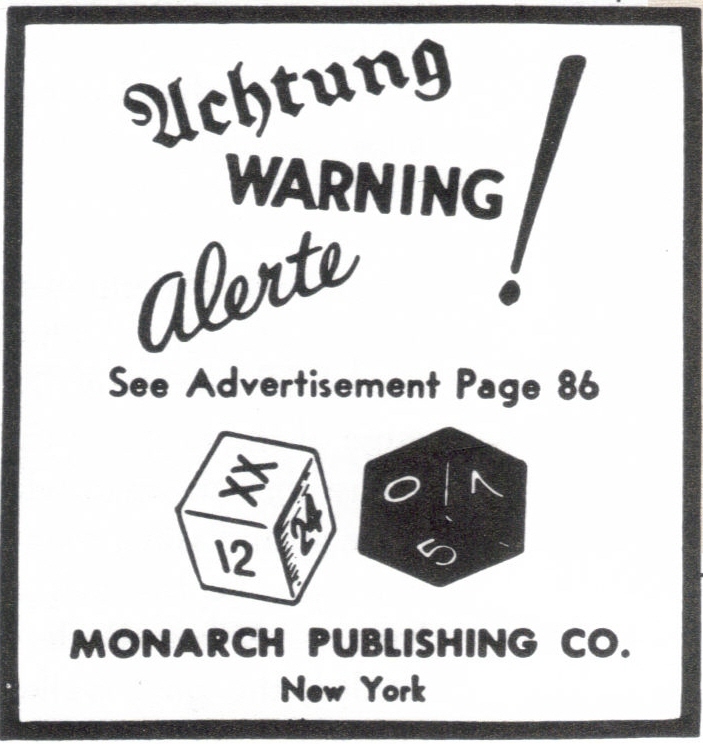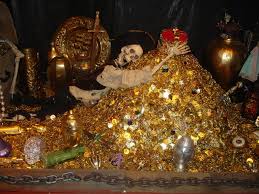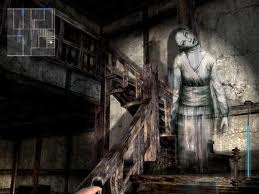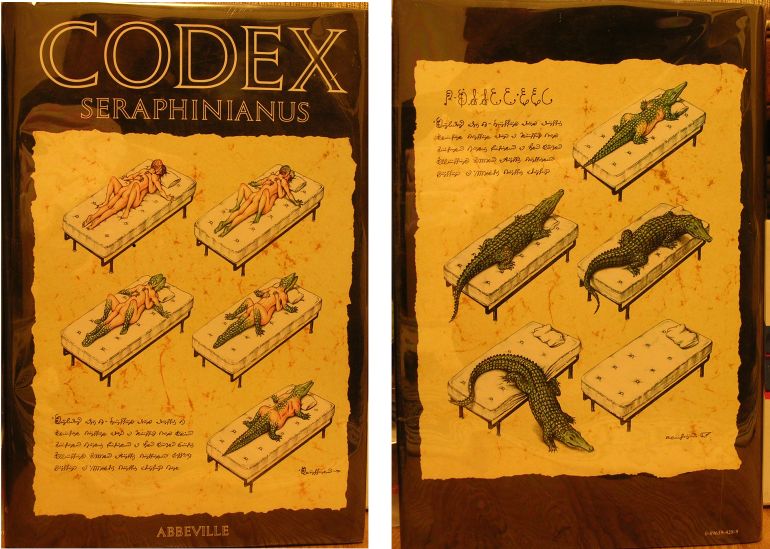
A few weeks before the Pearl Harbor attack,
a pair of strange ads appeared in the New Yorker. They seemed to be
advertising a dice game called The Deadly Double. One of the ads showed a
pair of dice with the characters 0, 5, 7, xx, 24, and 12 on the visible
faces. Above were warnings in a variety of languages: "Achtung!
Warning! Alerte!" The other ad showed people in a bunker and explained
that the dice game was essential air raid survival gear. The company
logo was a suspiciously Germanic looking double eagle.
The ads have a somewhat strange design, but only in retrospect did they
appear to contain a coded message. The numbers could allude to the date
of the Pearl Harbor attack (12/7), with the other numbers representing
codes to be deciphered by sleeper agents in the U.S. The Deadly Double itself was thought to refer to the twin threats of Germany and Japan.
Like many mysteries, retellings of this story emphasize the unknown and
leave out crucial facts. The 0 and 5 are sometimes thought to foretell
the exact time of the attack, but the first aircraft opened fire on
Pearl Harbor at 7:48 a.m. local time. Books on mysterious events like to
leave this story unresolved, as though the identity of the ads' creator
remains unknown to this day. In truth, it was traced to a game company
in Chicago that made a dice game called the Deadly Double. Their war-themed ad might seem like poor taste today, but the numbers on the dice matching the date of Pearl harbor was pure coincidence. Still, it was weird enough that the FBI got involved.
No
sooner had the Japanese bombed Pearl Harbor, Hawaii on December 7,
1941, that the home front became obsessed that lurking in the shadows
was a Japanese traitor or Nazi spy, saboteur, or subversive hiding
behind every bush, gathering all of the United States’ valuable
information.
As a result of the attack on Pearl Harbor, the nation was on high alert for spies, especially “suspicious looking Orientals.”
Many law enforcement officials took matters into their own hands. At a
major naval base in Norfolk, Virginia, the chief of police located all
Japanese aliens living in his city and ordered them jailed – all
fourteen of them. In Newark, New Jersey, police officers’ were given
the authority to board trains and arrest all suspicious looking
Orientals and to use their own judgement when determining if an
individual of Oriental origin “looked suspicious” or not. Other state’s
followed, singling out many individuals as “suspicious looking
Orientals.”
Creepy Coincidence of the Deadly Double - Pearl Harbor advance-knowledge Conspiracy Theory

The year was 1859. Four unsavory characters were serving as mercenaries
for the Peruvian Army. A Spaniard (Diego Alvarez), an Irishman
(Killorain), an Englishman (Luke Barrett) and an American (Brown). They
figured there had to be a way to make better money and were looking for
opportunities.
One of the men ran into a renegade priest named Father Matteo. The
priest told the man of a treasure hidden and guarded at a church in the
town of Pisco. The four came up with a plan, deserted from the army and
made their way to Pisco.
Alvarez and Killorain were both Catholic and started to attend mass
regularly. They became model parishioners. After some time they went to
the local priests with a terrible story. They had found out that a
renegade priest by the name of Father Matteo knew about the treasure and
was gathering up a large group of bandits to come and steal the
treasure.
The Priests believed the story. These men could know nothing of the
treasure on their own. Father Matteo must be up to something. Alvarez
came up with a plan to save the treasure. They could load the treasure
onto a ship and move it to the safety of Callao. Alvarez and his three
friends would gladly donate their services as guards.
So it came to pass that the priests loaded the following on a ship in the tiny harbor of Pisco:
- 14 tons gold ingots
- 7 great golden candlesticks, studded with jewels
- 38 long diamond necklaces
- A quantity of jeweled rings
- A quantity of jeweled bracelets
- A quantity of jeweled crucifixes
- 1 chest uncut stones
- 1 chest Spanish doubloons
- Various other jewels and ornaments
Hidden Treasures - Treasure Chest of the Church of Pisco

The
Isdal woman (Norwegian: Isdalskvinnen) is the subject of an unsolved
case involving an unidentified woman found dead at Isdalen Valley in
Bergen, Norway on 29 November 1970. Considered one of Norway's most
profound mysteries, the case has been the subject of intense speculation
over the years regarding the identity of the victim, the events leading
up to her death and the cause of death. Public interest in the case
remains significant.
The woman was found in a part of Isdalen popularly known as "Death
Valley", which lies in the direction towards Mount Ulriken. Next to the
scene police found a burned-out passport. The autopsy showed that the
woman had suffered blunt force trauma to the neck and had taken several
sleeping pills before she died. The official police report concluded
suicide, but this conclusion is highly controversial.
Discovery
On 29 November 1970 at approximately 13:15, while hiking in the hills of
Isdalen valley outside of Bergen, a university professor and his two
young daughters came across the partially charred remains of a naked
woman hidden among some rocks at a remote hiking trail. Present at the
scene were large amounts of sleeping pills, and bottles of petrol. A
full scale murder investigation was immediately initiated and the case
has since evolved to become the most comprehensive criminal case by the
Bergen police.
Investigation
Police traced the woman to two suitcases that were found in an NSB train
station in Bergen. Police also found that the labels had been removed
from every piece of clothing she wore, and that her fingerprints had
been sanded away.
In addition, police discovered a prescription for a lotion, but both the
doctor's name and date had been removed. Within the lining on one
suitcase police discovered 500 German marks. Partial fingerprints were
found on a few pieces of broken glass. They were insufficient for an
identification, but police suspected that they belonged to the dead
woman. The police had made phantom drawings on the basis of witness
descriptions and analysis made from the body; these drawings were
published in the media and disseminated via INTERPOL in a number of
countries.
The Mysterious Norwegian Woman - The Isdal Woman Spy Thriller

The Himuro Mansion (or Himikyru Mansion) is a japanese urban legend
about the dark history of a haunted house and the horrible murders of
an entire family who lived there. They say that the video game Fatal
Frame was based on a true story. Eager to solve the mystery, many people
have scoured maps, trying to find the real location of Himuro Mansion.
According to the legend, the Himuro Mansion is a large, traditional
Japanese house that is located in a rocky area somewhere on the
outskirts of Tokyo. The mansion became famous for being the site of the
worst mass murder in the history of Japan.
Terrible rituals were performed deep in Himuro Mansion, such as
the Strangling Ritual, the Demon Tag Ritual, and the Blinding Ritual.
The Strangling Ritual and Blinding Ritual were performed in a hidden
room, not shown on the house's original plans. This room is connected to
the house by a long lattice corridor that starts at the Rubble Room.
These rituals were part of the Himuro family's duty to keep the Hell
Gate sealed. The family was able to do this for many years until Kirie's
ritual failed and caused The Calamity, killing most of the occupants of
the mansion and unleashing the Malice, cursing the mansion and all who
die within it. The Himuro Family Master then killed all those in the
house who survived The Calamity before taking his own life.
A
folklorist named Ryozo Munakata moved in with his family to study the
mansion, but he and his family disappeared, killed by the mansion's
curse. Years later, Junsei Takamine and his research team went to
investagte the masion for Takamine's newest work and disappeard, leading
Mafuyu Hinasaki to the masion in search of them, where he too
disappeared. His younger sister, Miku Hinasaki, then arrives at the
mansion and breaks the mansion's curse to rescure her brother.
The Himuro family were said to have practiced ancient and
forgotten Shinto rituals that had long ago been outlawed in Japan. One
of these occult rituals was called “The Strangling Ritual” and involved
the sacrificial murder of a young girl. The purpose of this
gruesome ritual was to protect the Himuro family from bad karma which
they believed would emerge from a portal in the mansion’s courtyard.
Himuro Mansion Haunting - Urban Legend of Haunted House & Horrible Murders

Some
people think it's one of the weirdest books ever published. An art book
unlike any other art book. A unique and disturbing surreal parody.
Grotesque and beautiful. It's very hard to describe. Codex Seraphinianus
by Italian artist Luigi Serafini is a window on a bizarre fantasy world
complete with its own unique (unreadable) alphabet and numerous
illustrations that borrow from the modern age but veer into the
extremely unusual.
Codex Seraphinianus, originally published in 1981, is an illustrated
encyclopedia of an imaginary world, created by the Italian artist,
architect and industrial designer Luigi Serafini during thirty months,
from 1976 to 1978. The book is approximately 360 pages long (depending
on edition), and written in a strange, generally unintelligible
alphabet. Originally published in Italy, the book has since been
released in a number of different countries.
The word "Codex" in the title means "book" or "code" (from Latin
caudex), and "Seraphinianus" is derived from the author's last name,
Serafini (which in Italian, refers to the seraphs). Literally, Codex
Seraphinianus means Serafini's code. It was first published in two
volumes by Franco Maria Ricci in 1981. The pictures in this AbeBooks
article are from the 1983 American edition published by Abbeville - 370
pages of the Twilight Zone. There is also a 1993 single volume edition
and a revised 2006 Italian edition with new illustrations - this final
edition is the most affordable version.
Created in the late 1970s, the book's blurb on the cover flap talks
about Codex Seraphinianus being a book for the "age of information"
where coding and de-coding messages is increasingly important in
genetics, computer science and literary criticism. "The Codex presents
the creative vision of this time..." goes on the blurb. If Serafini was
so influenced by "information" in the 1970s to create this maverick art
book, then what must he make of today's information age? Codex
Seraphinianus Covers featuring Facebook, Twitter, blogs and Google?
Countless websites and blogs can be found pondering the meaning of Codex
Seraphinianus or simply admiring a truly original piece of
art/fantasy/imagination - call it what you will.
Codex Seraphinianus - The World's Weirdest Book

Born
into a wealthy family with Hungarian origins from Bucharest, Romania,
the family relocated to the town of Berkerekul (former Yugoslavia) when
Renczi was ten. By the age of fifteen, she had become increasingly
unmanageable by her parents and had frequently run away from home with
numerous boyfriends, many of whom were significantly older than herself.
Early childhood friends described Renczi as having an almost
pathological desire for constant male companionship and possessing a
highly jealous and suspicious nature. Although Vera Renczi was a
stunningly beautiful woman (according to the standards of the time, I
guess), she was also one of the most prolific female serial killers in
history, driven by a pathological need for devotion from men.
Renczi's first marriage was to a wealthy Bucharest businessman many
years her senior and she bore him a son named Lorenzo. Left at home
daily while her older husband worked, she began to suspect that her
husband was being unfaithful. One evening, in a jealous rage, Renczi
tinctured the man's dinner wine with arsenic and began to tell family,
friends, and neighbors that he had abandoned her and their son. After
approximately a year of "mourning", she then declared that she had heard
word of her supposedly estranged husband's death in a car accident
Shortly after hearing the news of her first husband's "automobile
accident" Renczi again remarried, this time to a man nearer her own age.
However, the relationship was a tumultuous one and Renczi was again
plagued by the suspicion that her new husband was involved in
extramarital affairs. After only months of marriage the man vanished and
Renczi then told friends and family that the man had abandoned her.
After a year had passed, she then claimed to have received a letter from
her husband proclaiming his intentions of leaving her forever. This
would be her last marriage.
Vera Renczi – The Black Widow Serial Killer Who Killed All Of Her Lovers






